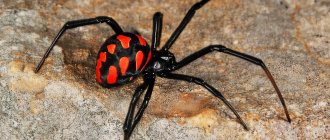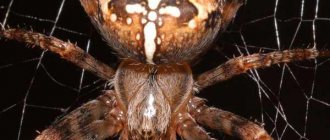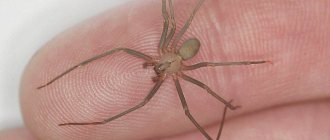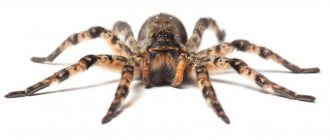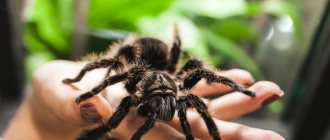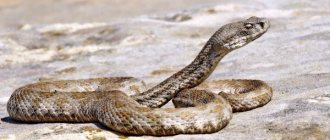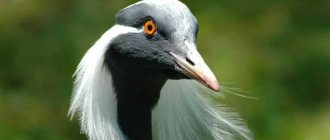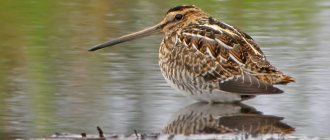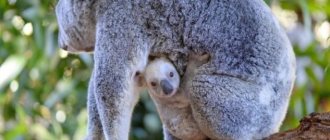The South Russian tarantula or Mizgir (Lycosa singoriensis) is a relatively large arachnid whose habitat is gradually expanding. More and more often, the spider is found in gardens and vegetable gardens, and sometimes it gets into houses. The impressive size of the spider and other external features often frighten people, who, in turn, provoke the tarantula to attack.
South Russian tarantula (mizgir), appearance
Name
In Russian and Ukrainian it is called the South Russian tarantula (due to the distribution of the species in the south of Russia). Popularly called “mizgir”.
In other languages, it is often named after the territories where it is found: Romanian (Romanian românească), Tatar (Czech tatarský), Ukrainian (Polish ukraińska), Dzungarian and the like.
Female
Lifespan
The lifespan of Lycosa varies greatly and depends on two factors:
- frequency of molting: the more often a spider molts, the less it lives;
- the possibility of falling into seasonal hibernation.
In nature, Lycosa singoriensis lives for approximately 2 years. In captivity, he does not have the opportunity to hibernate and stop developing for a while. Because of this, the life expectancy of the arthropod is reduced to 1 year. A too-fed life also shortens the life of a spider in an apartment. The more an arthropod eats, the faster it grows and is forced to molt. Shedding takes too much vitality. You can avoid very frequent changes of skin if you keep the animal from hand to mouth.
On a note!
You need to feed the spider once every 1.5-2 months.
Description
One of the largest spiders in Europe, the largest in Central Europe and Ukraine. Body size up to 4 cm, with legs up to 7 cm. Body weight from 2.6 to 7 grams. The upper side of the body is variegated, the sides are light, the upper side of the abdomen is black. The body is covered with gray and white hairs of different lengths, so it looks shaggy. On the cephalothorax there is a pattern of dark stripes extending radially from the center. The main segment of the chelicerum is bright yellow or orange, the tip and claw are black. The pedipalps are also yellow except for the black tip. Legs underneath with black rings.
Thanks to its protective coloring, the South Russian tarantula is perfectly camouflaged on the soil surface
Sexual dimorphism
Females have a larger abdomen and short legs compared to males and are stockier. The hairs of males are lighter. The size of males is 14–27 mm, females - from 18 to 31 mm, according to some sources - up to 35 mm.
Male
Races
There are three “races” of South Russian tarantulas: large, small and intermediate. The large one is found only in the south of Central Asia, the intermediate one is found most northern. Small common in the south of the steppes. All races interbreed freely with each other.
Dangerous classes
Species of arthropods that inject toxic substances with their bite. The consequences of such sabotage must be eliminated by resorting to medical assistance. To protect yourself from danger, you need to know the names and description of the appearance of this type of spider.
Common crosses
These are spiders from central Russia. They eat small insects that get caught in the web (flies, bees, hornets, butterflies). The specimen's venom contains liquid digestive enzymes that paralyze the victim and soften its body. In a well-fed state, the spider leaves its prey for later, hanging it on the edge of the web.
The spider is considered a forest spider; individuals can be observed in watery areas, meadows and orchards.
The body color fully justifies the name of the arthropod. On his back there is an ornament in the form of a cross.
Additional Information! During the hot season, the body of this arachnid acquires a waxy coating, which serves as a barrier to the abundant evaporation of fluid in its body.
The spider has 2 pairs of eyes. The transition from the head to the abdomen is equipped with an armor-like cover, on which 6 arachnoid warts with many microscopic pores are located.
The mating season occurs in August. The male pulls the signal web on the net, calling the chosen one to the act. At the end of the mating, the female eats it. After laying eggs, she also dies. The eggs spend the winter in a cocoon prepared by the mother. Spiders are born in mid-spring. The young reach maturity after the end of the next winter.
Harmful chiracantids
The habitat of this poisonous representative of arthropods is grass and shrub thickets in the middle zone. The variety is called stray because it does not weave web traps. The spider hunts mainly at night, hiding in the dark. It attacks in a jump as soon as it feels the victim's touch. It feeds on caterpillars, grasshoppers, moths, aphids, and is wary of wasps and ants.
The oval body, tapering towards the bottom, is colored yellow or green. The front legs are longer than all the others. The female can reach sizes from 5 to 15 mm.
Symptoms and consequences of a bite:
- acute pain in the affected area;
- burning;
- spread of symptoms over the skin;
- swelling and dull pain of the lymph nodes;
- labored breathing.
There is no itching or paralysis of muscles, provided that assistance is provided in a timely manner. Other symptoms weaken and disappear within 48 hours.
Poisonous karakurt
This species of arachnid is considered to be extremely poisonous and inhabits the southern regions of the Urals and the Caucasus. With climate warming, the habitat boundaries are expanding to the northern regions, Siberia.
An outdoor species of arthropods that do not live inside houses and buildings, but build burrows near dwellings, mainly in cluttered areas. They quarrel with wasps and hedgehogs.
The body of the spider is black or gray with red spots. With age, the body darkens and the striking spots become dull.
The greatest danger is the female after several molts. The young specimen is not very poisonous.
The female builds a den in depressions in the soil and often inhabits rodent burrows, placing a web barrier at the entrance. The eggs overwinter in a cocoon; in the spring, the young are scattered by the wind along with the cobwebs.
Additional Information! The enemies of this spider are repelled by its protective coloring, or rather by the striking red spots on its abdomen. Predators avoid arthropods.
The karakurt attacks animals and humans if it is disturbed.
Symptoms:
- rapid burning pain;
- acute spasms in the abdomen, chest, lower back;
- difficulty breathing, shortness of breath;
- increased heart rate and pulse.
If help is not provided in a timely manner, consciousness becomes confused, accompanied by a delusional state. To neutralize the poison, an antikarakurt solution, novocaine, sodium bisulfate, and calcium chloride are used. The infected person needs immediate medical attention.
South Russian tarantula
The largest spiders in Russia are light gray in color, up to 30 mm in size, with a lifespan of up to 2 years. Lives in areas with a dry climate (forest-steppe, semi-desert, steppe). Among the most common places are Tambov, Lipetsk, and Astrakhan regions. Lives in a deep hole, which he digs himself, covering its walls with cobwebs. It detects the prey by the shadow when it moves near the predator's lair. Instantly pounces and bites. The prey becomes completely paralyzed.
It catches prey by jumping on it from a height of 15 cm. An arthropod bite does not cause acute pain, but without medical intervention it can cause the following symptoms:
- nausea;
- fever;
- swelling of the lymph nodes.
Death is unlikely, but health problems are common.
Individuals copulate closer to autumn. The female tarantula is attracted by the sound of vibrations from the abdomen, while vigorously jerking its legs. After mating, the male runs away. The spider bears her offspring in a woven cocoon, which she attaches to her body. After the children hatch, the mother breaks through it and releases the babies, puts them on her body and carries them until they get stronger.
The spider spends the winter in a hole, clogging the entrance with soil.
Important! The presence of hypersensitive hairs on its paws allows the tarantula to hear human footsteps at a distance of several kilometers.
Lifestyle
The lifestyle is similar to that of the closely related Apulian tarantula (Lycosa tarantula).
Female in the ornithological reserve Bulakhovsky Estuary, Ukraine, Dnepropetrovsk region
Nutrition
The female South Russian tarantula digs a more or less vertical hole up to 50–60 cm deep, the inner wall of which is covered with cobwebs. The entrance to the hole is about the diameter of a mouse hole, the web protrudes from the surface of the soil and is reinforced by twisted stems of grass and other plants. It does not build a trapping net, but reacts to the movement of prey, which approaches the edge of the burrow and pulls the signal spider threads: it jumps out of the burrow and bites. At night it moves a short distance from the shelter. It most often hunts beetles and orthoptera, but any insects and smaller spiders can become prey.
At the entrance to the hole
Reproduction
Tarantulas mate in late summer. The male approaches the female's burrow and taps the web with his front legs. The female comes out, and then he begins to stroke her limbs with a slight vibration of his legs. Sometimes the female will still attack the male. When the male manages to calm her down, he enters the hole, where mating takes place.
Entrance to the hole
In the spring, the female lays 200–700 eggs in a cocoon, which she warms in the sun, crawling out to the edge of the burrow and sitting there upside down, with her abdomen with the attached cocoon out. After the small spiderlings hatch (usually in May), she collects them on the upper part of her abdomen and travels, from time to time dropping some of the offspring, thus distributing them. At the same time, the female can swim across small water obstacles.
The female before laying eggs. After laying eggs, the size of the abdomen decreases sharply
Female with cubs, Chelyabinsk region
Tarantulas grow during molting, molting 11 times.
Female with young
Growing at home
South Russian tarantulas are rarely found as pets. It is interesting to watch them while hunting and while arranging their home. It won't be possible to tame.
If the spider notices too intrusive attention, it will bite. At home, South Russian tarantulas live from 1 to 3 years. In warm conditions, Mizgir does not hibernate, which slows down its development.
An ordinary aquarium can also become a home for a tarantula, but it must have good ventilation. The length and width of the container should exceed the paw span by approximately 3 times. A cover is also required - the spider can easily jump up to 20 cm, and can also get out into the corners, entwining them with cobwebs.
You need to pour loose material on the bottom:
- sand;
- vermiculite;
- turf;
- coconut fiber;
- peat.
As an option: on one side of the container - clay and sand in half, on the other - vermiculite and black soil. The thickness of the layer must be at least 40 cm so that the tarantula can dig a full-fledged hole. The poured soil is constantly slightly moistened. You can plant plants and put natural shelters: driftwood or branches. There is a lamp on top (mizgiri like to warm themselves).
Cleaning must be done every 2 months. The spider is removed with a net or lured with food into another container.
You can catch food for your tarantula yourself or buy it at a pet store. These could be cockroaches, crickets, mealworms, moths, and larvae. Young spiders are allowed to be given as many insects as they can consume.
Usually they launch 5-7 cockroaches. If the tarantula does not eat for 5-6 days (this usually happens before molting), then the insects need to be caught. For adults, it is enough to feed them once a week (1-2 crickets or cockroaches). Tarantulas can live without food for about a year, but they must always have access to water.
It should be taken into account: the better the Mizgir feeds, the more often it will shed - the chitinous shell becomes tight as it grows. However, the number of molts is directly proportional to the spider's lifespan. A strict diet will prolong its existence.
At home, females also breed offspring, which spread out after about 3 days (on the 4th day the body of the young is the size of a match head). Then the spider weakens and dies. For active growth of young animals, a stable temperature (30-31˚) and abundant nutrition are required.
Video
South Russian Tarantula (Lycosa Singoriensis) or Mizgir - Housekeeping!
Natural enemies
Tarantulas are preyed upon by parasitoid road wasps (pompylids), which paralyze the spiders and lay eggs on them, from which a larva develops that slowly eats the spider. In particular, these are Anoply Samara (listed in the Red Books of Chuvashia, Ukraine and Moldova) and Cryptochol annularis (listed in the Red Book of Ukraine).
Cryptocheilus alternatus
The eggs are destroyed by various species of ichneumon ichneumon. Young tarantulas are hunted by mole crickets.
In Kazakhstan, tarantulas are eaten by the endemic rodent Selevinia, which, however, is rare.
Interesting classification
Everyone knows that there are lovers of large tarantula spiders who classify their favorites depending on their speed characteristics. For example:
- For Dummies" . These are slow-moving members of this species that many people like to film. They can sit quietly on the palm of a person and move extremely slowly.
- For the “advanced” . These arthropods move quite quickly, so it’s unlikely to be captured on video.
- For professionals . They move so quickly that it is unlikely to notice in which direction the arthropod disappeared.
If we take into account such speed characteristics, it is not difficult to imagine how many species humanity does not yet know about.
THE STRANGE AND UNUSUAL SPIDERS IN THE WORLD
Spreading
Distributed in deserts, semi-deserts, steppes and forest-steppes from Austria and Hungary to the Caspian Sea, Central Asia, Southern Siberia, the Russian Far East and Northwestern China. Also lives in Turkey, the Middle East, and Egypt. In Ukraine, it is distributed throughout almost the entire territory, except for the main part of the Carpathians (however, it is found in the Volcanic Massif). Occasionally found further north, especially along river banks with sandy soils.
The most popular representatives
Represented by a large number of representatives. Each spider is endowed with certain capabilities and is perfectly adapted to life in its region. Due to the fact that climate change has been observed over the past decade, the geography of arthropod habitats is changing. Species that previously occupied only certain regions migrate and colonize new territories.
Jumping spider
The jumping spider is found throughout Russia and is considered one of the best helpers for gardeners. Its advantage is the inability to bite through the human body. You can keep such a spider on your site to combat garden pests. It is enough to catch several individuals and plant them in a garden bed or under a tree. The horse will not be confused - it will immediately begin to spin a web and settle in a new place.
Pisaurid
They live in Siberia and the Far East. This species is predominantly characterized by gift-giving during the courtship period. The male, when preparing to meet his beloved, carefully packs the caught flies or midges into a cobweb cocoon. This offering reduces the chance of being eaten and increases the chance of mating.
Crosses
Crossweeds are one of the most common species of the orb weaver family. They live throughout the Russian Federation, make a great contribution to the fight against harmful insects and easily adapt to a new place of residence.
Recluse spider
A tiny spider, no more than 8 mm in size, with a leg span of up to 2 cm. A distinctive feature of the cross spider is its wide legs and a striped, elongated body, with a characteristic cross-shaped pattern. Color varies from brown to dark brown.
The hermit spider weaves its web randomly, as necessary. It is formed by careless and chaotic movements during the weaving process. The hermit's bite is not fatal. But its poison contains substances that strongly break down the skin, which threatens tissue necrosis (death).
Security
It is included in the Red Books of many constituent entities of Russia, in particular the Moscow, Kaluga, Ryazan, Tula, Sverdlovsk and Nizhny Novgorod regions, and the Perm Territory. In Ukraine, it is included in the list of animals subject to protection in the Kyiv region.
In the landscape reserve of national significance Soleny Liman, Ukraine
Nutrition
All insects and animals that are smaller than the tarantula are at risk of being eaten. They do not stray far from their burrow to hunt. They draw in their victim and are already having their meal at home. This happens somewhat unusually for them.
Spiders do not have teeth, so when they approach their victim, they pierce a hole in it, through which they inject their special agent to dissolve all the insides of the victim. And after that they suck out the dissolved contents without any problems.
South Russian tarantula and man
Unlike the Apulian tarantula, the South Russian tarantula is almost not feared in its range. There are even reports from Ukraine of children playing with tarantulas to pass the time.
Bite incidents and toxicity
The spider's chelicerae are large and strong enough to bite through human skin. However, the effect of the poison itself has practically no significant consequences for humans. Redness and swelling occur in the area of the bite wound. Rarely, the bite can also cause a fever. In any case, bites are rare due to the low aggressiveness of the spider. As a rule, in case of danger, the South Russian tarantula prefers to hide and bites only if there is no other way out - for example, a spider has been driven into a corner. Before biting, it straightens up and raises its front pairs of legs.
In a terrifying pose
The internal structure of the body of spiders
Spiders are distinguished by the fact that they do not have a full-fledged circulatory system, as well as no blood, which is replaced by lymph. There is a heart, but a peculiar one, consisting of 3 or 4 holes, called awns. Through these openings, lymph enters the heart area, after which it is distributed throughout the body into the spaces between the internal organs. After this, the lymph enters the pericardial region of the body and is sent back to the heart. With the help of lymph, the spider receives the necessary portion of oxygen.
The spider's respiratory organ also has a unique structure. The respiratory system consists of plate-shaped pulmonary sacs that resemble books. The breathing holes are protected by special covers that open at the right time. The respiratory system also includes trachea tubes, which supply oxygen to the internal organs.
Spiders, despite the fact that they are predators, have a well-developed central nervous system consisting of nerve cells. Nerve formations are located in the cephalothorax, and from them nerve endings are distributed, directed to all organs of the animal. These nodes, the number of which is 2, are the brain of the animal.
It is important to know! The number of nerve cells is very significant, since the volume of the brain accounts for up to 30% of the useful volume of the cephalothorax.
Interesting facts about the Cornerot jellyfish
There are several interesting facts about it, but the main one is that some types of these animals are eaten by people. For example, the edible sawweed (from the Latin Rhopilema esculenta) is considered a popular species. This jellyfish is part of the national dishes of Japanese and Chinese cuisines.
Another interesting fact is that such meat is not consumed in its pure form. Jellyfish are usually added to various salads, which are subsequently flavored with a huge amount of all kinds of seasonings.
Cornerot is harmless as long as it is not disturbed. However, as soon as the animal feels irritated, the tentacles will immediately release poison that can cause a serious burn.
Watch a video about a poisonous jellyfish in the Black Sea:
Black Widow
In the photo: a female black widow guards a egg cocoon.
The bite of Latrodectus mactans poses a serious danger to humans. These creatures are also unkind to their relatives. So, for example, females eat males after mating, hence the name - widow. Moreover, the poison is more toxic in females.
This type of spider also belongs to the genus of the same name, which has 31 species. Not all types of black widows are dangerous.
They often crawl into people's houses in search of a more comfortable place for a brood of spiderlings. The female guarding the egg cocoon is very aggressive. She can easily bite anyone who invades her territory. Once in the human body, the poison provokes convulsive muscle contractions. And before the invention of the antidote, about 5% of people bitten by a black widow died.
Yes, and the male sometimes manages to escape from the female after mating!
5
How do they reproduce?
Most often, reproduction in tarantulas occurs in the second half of August. The male weaves a web somewhere in a safe place, and then rubs his abdomen against it. Ejaculation occurs, the fertilization fluid remains on the web. After this, the male lowers the pedipalps there, they absorb the seed and become ready for fertilization of the female tarantula.
Spiders have a courtship period - when they find a female, they perform a dance for her. If the female responds favorably, the male lowers the pedipalps into her cloaca, after which fertilization occurs. An interesting point: the male needs to hide from the fertilized individual as quickly as possible, otherwise she may eat him.
After fertilization, the concern for prolongation of the race passes to the female. She weaves a cocoon where the eggs will be laid. The maximum quantity per clutch is up to 2,000 eggs. They mature for up to 50 days, after which small arthropods are born. As a rule, they reach sexual maturity by 2-3 years.
Mizgir bite
The spider is not aggressive and does not attack first. Its poison is not fatal to humans, but is dangerous to small animals. The bite can be compared to a hornet sting. Symptoms may include:
- swelling, burning;
Tarantula bite.
- presence of 2 punctures;
- redness;
- pain;
- in some cases, increased temperature;
- yellowed skin in the affected area (the shade may persist for 2 months).
The bite of a South Russian tarantula is dangerous only for a person prone to allergic reactions. A person develops a rash, blisters, vomiting, a very high temperature rises, the heart rate increases, and the limbs go numb. In such cases, immediately call an ambulance.
First aid for a misgir bite
A few tips for disinfecting the wound and restoring the skin:
- wash the bite site with soap and water;
- treated with any antiseptic. Hydrogen peroxide, alcohol, vodka will do;
- apply ice to relieve pain;
- take antihistamines;
- apply an anti-inflammatory agent (for example, Levomycytin ointment);
- drink a lot of fluids to remove toxins from the body;
- The bite site is kept elevated.
Goliath tarantula
Are you afraid of spiders? After meeting this species, you will become even more afraid of them. Theraphosa blondi is also known as the tarantula spider or goliath tarantula. What does this monster look like? Adults can reach sizes of up to 25 centimeters, with legs measuring 15 centimeters long and body length 10 centimeters.
15
